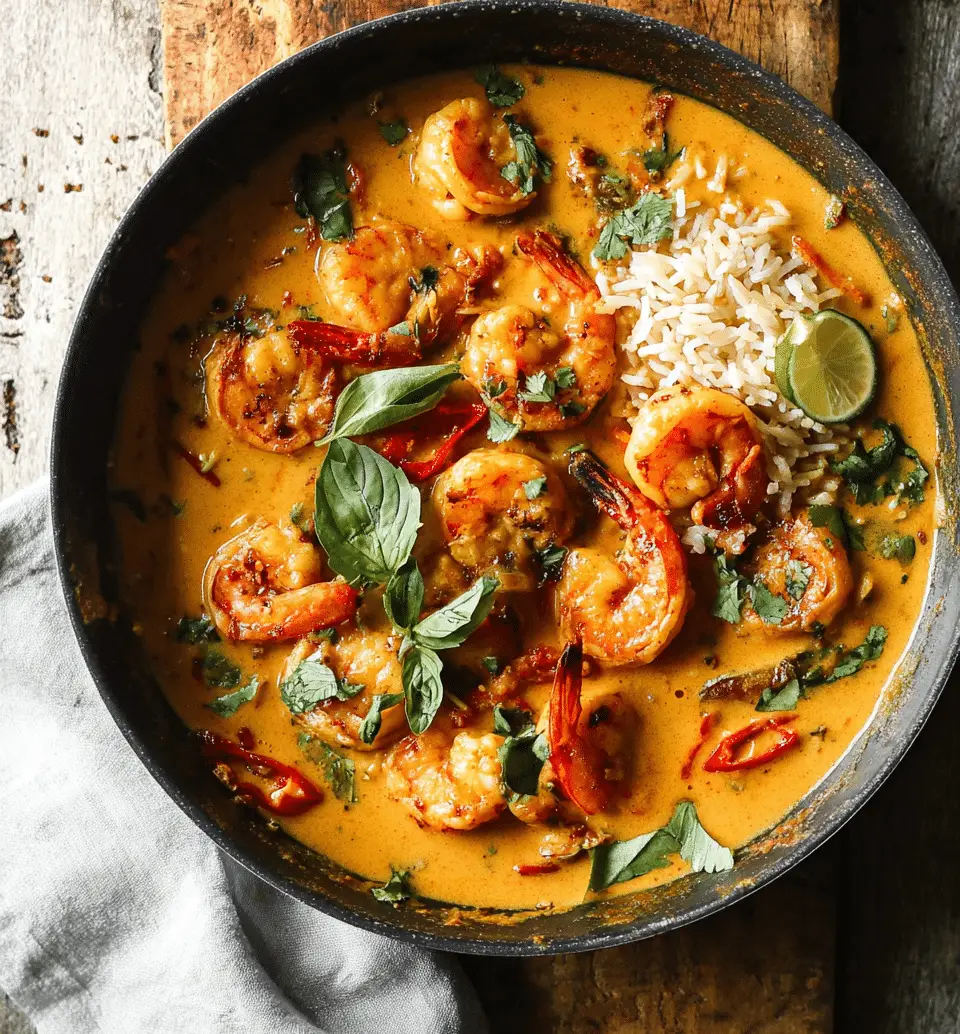Why Choose Thai Coconut Shrimp Curry?
One of the main reasons Thai Coconut Shrimp Curry is so popular is because of the versatility and complexity of its flavors. The richness of coconut milk, combined with the depth of the red curry paste, creates a sauce that is both soothing and aromatic. The shrimp, when cooked perfectly, absorb the flavors of the curry, making each bite a delightful experience.
The beauty of this dish lies in its simplicity. With a few key ingredients like shrimp, coconut milk, and curry paste, it’s easy to recreate the delicious flavors of a Thai restaurant in your own home. It also offers a balance of nutrients, with shrimp providing lean protein and the coconut milk adding healthy fats. Moreover, the vegetables and herbs bring vitamins and antioxidants to the dish, creating a well-rounded meal.
The Ingredients That Make the Dish Unique
Each ingredient in Thai Coconut Shrimp Curry plays a crucial role in building the dish’s distinct flavor profile. Let’s explore how these ingredients come together to create something extraordinary.
-
Shrimp: The star of the dish, shrimp, adds a delicate seafood flavor that complements the bold spices and coconut milk. Shrimp cooks quickly, making it an ideal protein for this fast weeknight dinner. It also soaks up the curry sauce, resulting in a tender, flavorful bite.
-
Coconut Milk: Coconut milk provides the creamy texture and a subtle sweetness that balances the heat from the curry paste. It also gives the curry its luxurious consistency, making it the perfect base for the sauce.
-
Red Curry Paste: Red curry paste is the backbone of the dish, offering complex flavor with a mix of ingredients like dried red chilies, garlic, lemongrass, and galangal. It provides the necessary heat and aromatic depth to the dish.
-
Fish Sauce: Fish sauce is a key ingredient in Thai cooking. It adds a salty, umami richness that enhances the overall flavor of the curry. It’s best used sparingly, as it can be quite potent.
-
Vegetables: The onion, bell pepper, and jalapeños not only contribute to the dish’s texture but also introduce fresh, crisp elements that balance out the creamy coconut milk. The bell pepper adds a slight sweetness, while the jalapeños bring the spice.
-
Thai Basil and Lime: Fresh Thai basil adds an herbal, slightly peppery note that is unmistakably Thai. Lime wedges served with the dish enhance the freshness and add a zesty acidity that brightens the rich curry.
The Nutritional Benefits of Thai Coconut Shrimp Curry
Aside from being delicious, Thai Coconut Shrimp Curry is a nutritious meal option. Let’s break down the key nutritional benefits that come from this dish.
-
Protein: The shrimp in this recipe is an excellent source of lean protein, essential for muscle building, immune function, and overall health. Each serving offers a substantial amount of protein to keep you full and satisfied.
-
Healthy Fats: The coconut milk in this curry provides a rich source of medium-chain triglycerides (MCTs), a type of fat that is easier for the body to metabolize and use for energy. While coconut milk is calorie-dense, it offers a more balanced fat profile compared to other types of cooking oils.
-
Vitamins and Antioxidants: The vegetables, especially bell peppers, provide a good dose of vitamins, including Vitamin C, which supports the immune system, and Vitamin A, which helps with vision and skin health. Thai basil also contains antioxidants that support overall health.
-
Low in Carbs: Compared to many other curry dishes, Thai Coconut Shrimp Curry is relatively low in carbohydrates. This makes it suitable for those following a low-carb or ketogenic diet. The addition of fresh vegetables ensures that the dish remains nutrient-dense without relying heavily on starchy ingredients.
How to Serve Thai Coconut Shrimp Curry
Thai Coconut Shrimp Curry is a versatile dish that can be paired with a variety of sides to complete the meal. Here are a few ideas for serving:
-
Steamed Rice: The most common way to serve this dish is over a bed of steamed jasmine rice. The rice soaks up the delicious curry sauce, making each bite flavorful. You can also use brown rice for a healthier, fiber-rich option.
-
Noodles: Another option is to serve the curry over rice noodles. This adds an extra layer of texture and allows the curry to be enjoyed as a noodle dish.
-
Vegetables: For a lighter option, serve the curry with steamed or sautéed vegetables like broccoli, bok choy, or snow peas. This can enhance the dish with more fiber and vitamins.
-
Garnishes: Top the curry with freshly chopped cilantro or more Thai basil, as well as a squeeze of lime juice to give it a fresh and zesty kick.
Making Thai Coconut Shrimp Curry Your Own
While this recipe is already flavorful and balanced, there are ways to adjust it based on your preferences or dietary restrictions. Here are a few variations you can try:
-
Spice Level: Adjust the spice level of the curry by adding more or fewer jalapeños or using a milder curry paste. If you want a spicier kick, you can also add a dash of chili flakes or hot sauce.
-
Protein Variations: While shrimp is the traditional protein used in this recipe, you can easily swap it for chicken, tofu, or even fish. Chicken thighs or breast work well, as does firm tofu if you’re looking for a plant-based option.
-
Coconut Milk Alternatives: If you’re looking for a lighter version, you can substitute the coconut milk with light coconut milk or use a blend of coconut milk and vegetable broth to reduce the calorie count.
-
Vegetarian Version: For a vegetarian or vegan take, simply omit the shrimp and replace it with additional vegetables like mushrooms, zucchini, or eggplant. You can also add tofu for protein.
Conclusion
Thai Coconut Shrimp Curry is a rich, flavorful dish that brings the authentic taste of Thailand into your home with minimal effort. With its blend of creamy coconut milk, aromatic red curry paste, tender shrimp, and fresh vegetables, it’s a dish that appeals to all the senses. Not only is it quick to prepare, but it’s also customizable to suit various dietary preferences. Whether you’re craving a comforting meal or looking to impress your guests with something exotic, this curry is sure to become a favorite. Enjoy the vibrant flavors and the nutritional benefits of this delicious dish, and make it a part of your regular dinner rotation.






